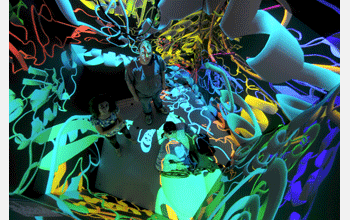Multimedia Gallery
StarCAVE at Calit2
A view from above and looking down into StarCAVE, a five-sided immersive, interactive virtual reality (VR) room where scientific models and animations are projected in stereo on 360-degree screens surrounding the viewer, and onto the floor as well. Users interact with the visuals displayed by pointing a "wand" that allows them to fly through the 3-D images and zoom in or out. The image being projected here is of RNA.
The VR environment allows groups of scientists to venture into worlds as small as nanoparticles and as big as the cosmos, allowing them to gain new insights that could fuel discoveries in many fields. StarCave was built at the California Institute for Telecommunications and Information Technology (Calit2) at the University of California, San Diego (UCSD). In the photo, clockwise from top, are Andrew Prudhomme, Doug Ramsey and Pinar Istek, all from Calit2.
More about this Image
StarCAVE is the third generation of surround-VR rooms. The original VR room--named Cave Automated Virtual Environment, or CAVE--was built at the University of Illinois at Chicago's Electronic Visualization Lab (EVL) in 1991, by Thomas A. DeFanti (currently director of visualization at Calit2) and his research team. Ten years later, a second-generation model was built at EVL that is now the standard surround-VR technology and is widely used around the world and marketed by Mechdyne Corp. While the first- and second-generation CAVEs require viewers to wear battery-powered 'shutter' glasses, StarCAVE provides an improved 3-D experience by allowing viewers to wear only lightweight, polarized 'sun' glasses.
The quality of imaging in StarCAVE is outstanding. The room operates at a combined resolution of over 68 million pixels--34 million per eye--distributed over 15 rear-projected walls and two floor screens. Each side of the pentagon-shaped room has three stacked screens, with the bottom and top screens tilted inward by 15 degrees to increase the feeling of immersion, while reducing ghosting, or 'seeing double.' Adding to the VR experience is a surround-sound system, which harnesses recent advances in wave field synthesis--a way to maximize the perception of many channels of sound emanating from different sides of the room.
"When you're inside the StarCAVE the quality of the image is stunning," says DeFanti. "The StarCAVE supports 20/40 vision and the images are very high contrast, thanks to the room's unique shape and special screens that allow viewers to use 3-D polarizing glasses. You can fly over a strand of DNA and look in front, behind and below you, or navigate through the superstructure of a building to detect where damage from an earthquake may have occurred."
For a full description of StarCAVE, see the report "The StarCAVE, A Third-generation CAVE and Virtual Reality OptlPortal."
[StarCAVE is an OptlPortal whose research is supported by a cooperative agreement between the OptlPuter Project and the National Science Foundation, under grant OCI 02-25642.] (Date of Image: June 2008)
Credit: Tom DeFanti, UCSD Calit2
See other images like this on your iPhone or iPad download NSF Science Zone on the Apple App Store.
Images and other media in the National Science Foundation Multimedia Gallery are available for use in print and electronic material by NSF employees, members of the media, university staff, teachers and the general public. All media in the gallery are intended for personal, educational and nonprofit/non-commercial use only.
Images credited to the National Science Foundation, a federal agency, are in the public domain. The images were created by employees of the United States Government as part of their official duties or prepared by contractors as "works for hire" for NSF. You may freely use NSF-credited images and, at your discretion, credit NSF with a "Courtesy: National Science Foundation" notation.
Additional information about general usage can be found in Conditions.
Also Available:
Download the high-resolution JPG version of the image. (7 MB)
Use your mouse to right-click (Mac users may need to Ctrl-click) the link above and choose the option that will save the file or target to your computer.



